The sun is peaking through the clouds after a long week of rain. Pouring through the gates of Smith Secondary Campus are hundreds of parents, siblings, guardians and one particularly proud Bibi (grandmother) named Apatakis. Today is the Form 4 Celebration and Awards Day.
The procession of guests is a never ending flare of fashion, with everyone dressed in their finest clothing, and the charismatic Bibi is at the pinnacle. She is garbed in a golden mtandio (scarf) with an elegant green kilemba (headwear) and a cascading dress peppered with pink and red flowers. A broad smile is planted on her face.
Bibi has always been stylish, and her reason is simple.
“I love myself,” she says, her smile becoming a laugh.
But today it’s not just her style that is a source of pride; more importantly it is her grandson, Johnson.
"Neither of us slept last night," says Bibi, gesturing to Johnson’s sister, Elinipe, who is also in attendance. "We are very thankful. We depend on Johnson, and his future is bright. He is always there to help me out."
From the age of two, Johnson was raised by Bibi and his older sister in a two-room compound, made from mud and sticks. For Bibi and Elinipe, today is not just a celebration of Johnson’s graduation, it is also a celebration of the love they share, and how their love has helped shape Johnson into the person he has become.
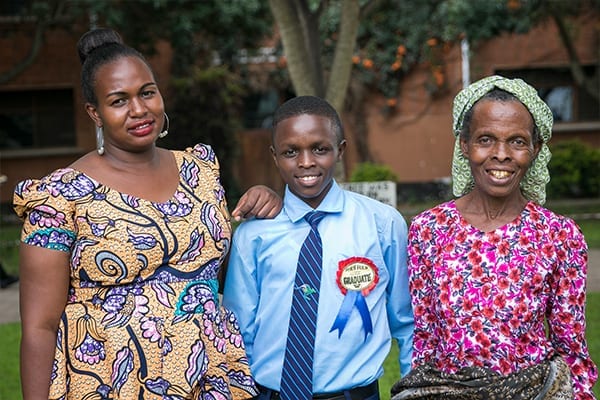
"We sacrificed a lot to help Johnson study," says Elinipe. "I was there to offer moral support, advice and to pray."
"I told him - 'don’t give up because you are the best, be a believer.'"
Elinipe was right to encourage Johnson. Last year, he was top of his class in Biology, Chemistry, Geography, and History.
"When I was young," says Johnson. "Bibi and my sister helped me out a lot - they were not ready to lose hope."
Bibi taught Johnson the importance of caring for others. Neighbours from the local community will often come to Bibi for advice about their problems.
"Growing up," says Johnson. "Our house was full of laughter and love."
As the beginning of the celebration ceremony approaches, Johnson rejoins his peers while Bibi and Elinipe assume their seats in the assembly hall.
The stage features enormous threads of blue and orange silk, dotted with stars. As the school choir begins singing, the 135 Form 4 students enter the hall, walking in two lines, parting the audience through the centre.
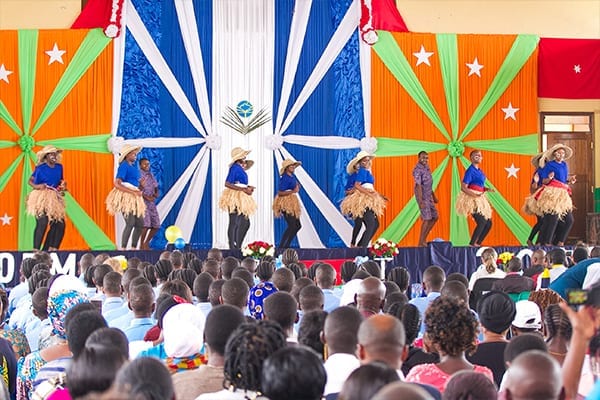
Bibi is impressed with the school uniforms, clapping enthusiastically. "They always look so smart," she says.
The Headmaster, Erespidus Fikiri, addresses the Form 4 students.
"This day is about you and what you have achieved through hard work, determination and moments of creative inspiration," says Mr Fikiri. "Today is just the beginning, it is where you go from here that matters."
Awards are presented after the Headmaster’s address, and Johnson is announced as the highest achieving student in Mathematics, topping the entirety of the year level.
Johnson is a hard-working student, something he inherits from his sister. Outside the classroom, he spends thirty hours studying every week. Often he can be found in the library reading books by the likes of Edward de Bono, the famed physician and psychologist.
"I’m looking towards the future now," says Johnson. "The next step is to become an engineer."
Another Form 4 student, Semu, takes the stage to give a speech on behalf of his classmates.
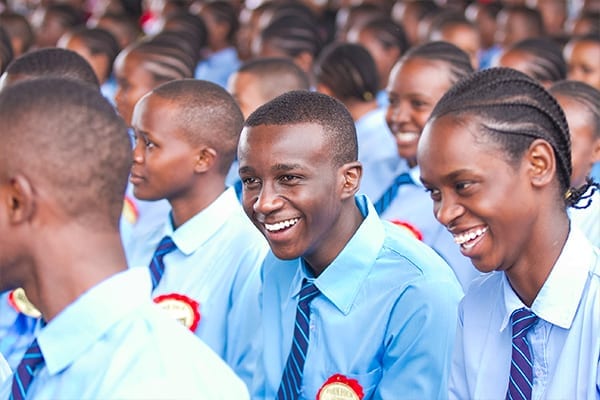
"We would like to say a word of thanks to our beloved sponsors and donors," says Semu. "School founder Mama Gemma, headmaster, level coordinator, teachers, parents and our fellow students."
Semu continues, "you helped us become a better version of ourselves and everything we achieved is all because of you."
Finally, the students are applauded individually as they are presented with their certificates.
To conclude, the Form 4 Class of 2019 take the stage, singing: "good bye, good bye, we will miss you, we thank you, good bye!"
St Jude's supports the poorest, brightest students. You can help educate more students like Johnson by donating today.
Recently, the Standard 7 students finished their national exams, ranking in the top 0.3% of Tanzania. A fantastic achievement that saw St Jude's climbed 30 places in the national rankings.
One would assume the students would want a well earnt rest – however, this is not the case, with 45 students voluntarily applying to help out around the school.
Every year, upon completing exams, St Jude’s offers the opportunity for Standard 7 students to volunteer for a range of activities. This year, a major focus has been for the students to teach English and Information and Communications Technology (ICT) to bus drivers and cooks employed by the school.
"It’s a way to put the teaching spirit in them," says Deputy Headmaster of Operations, Sebastian Gitbang. "The students get to use what they learn in class." Mr Gitbang originally planned to have 20 students participate in the volunteer program but was overwhelmed with applications, having to expand the program to include 45 students.

One of those students is Jackline, 14, who recently received straight A’s for her national exams. Jackline has been teaching bus drivers how to type.
"I like teaching because I learn new things," says Jackline. "Before I taught them, I had to teach myself first because I’d never typed before."
Jackline has found her students to be receptive and enthusiastic during class time.
"They are always doing their best to speak English," says Jackline. "Whenever they ask questions, they will ask in English."
Cornel, another teenage Standard 7 student, has been teaching English, and has a newfound appreciation for teachers.
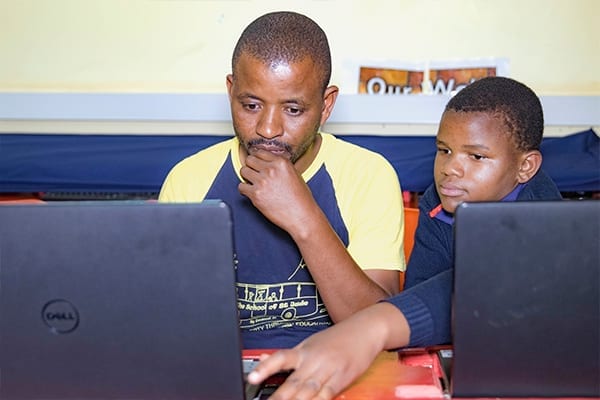
"It’s important to have confidence," says Cornel. "To be a good teacher you need to trust yourself, have knowledge of the topic, and be confident."
Cornel, alongside his peers Loveness, Amina, and Karen, have been teaching cooks and bus drivers.
The cooks and bus drivers , who mostly speak Swahili, have now mastered how to introduce themselves and greet people.
In Tanzania, being able to speak English is an important skill because it opens up more options for employment. This means students from St Jude’s take a particular pride in their English skills.
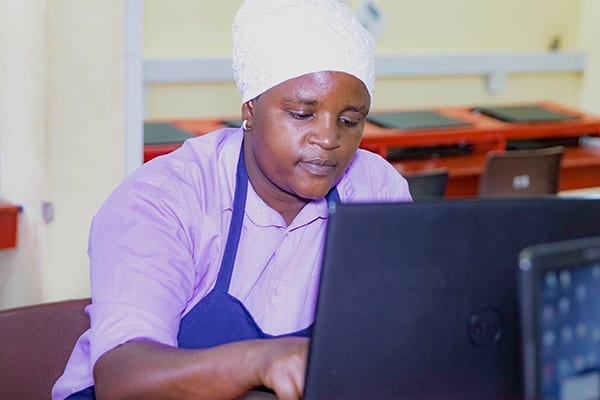
Moving forward, Mr Gitbang sees this program as essential in preparing the students for when they graduate and move onto Beyond St Jude’s (BSJ),and participate in the Community Service Year.
"It’s good to prepare them now," says Mr Gitbang. "So when they finish school they can give back by teaching in government schools."
For now, Mr Gitbang has his hands full as the volunteers are proving to be in high demand.
"I just got another email," says Mr Gitbang. "The students do such a good job, they are in demand. I’m always receiving emails asking if they can help out."
Instilling a pride for education is an important part of the St Jude's tradition. Help continue this tradition by sponsoring a student today.
Streamers crackle around the assembly hall like fireworks; it is teeming with rain, but no one seems to notice. Today is the tenth annual Cultural Day at Smith Secondary Campus.In front of the stage sits the entirety of Smith Campus, swaying to the beat of Tanzanian bongo flava music, blaring from speakers.
The theme for this year is art, culture and employment.
Two Form 4 students, Semu and Jessica, take the stage: "say, 'I’m African and I’m proud!'" they project to the crowd.
"I’m African and I’m proud!" the audience responds.
“Our art and cuture is an opportunity for employment,” says Semu. “It is now our chance to use it.”
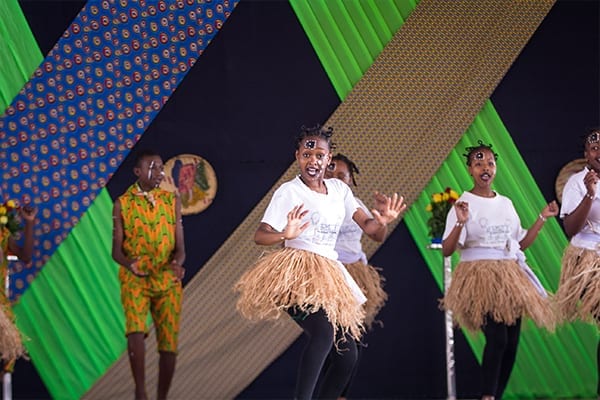
Throughout the day, hundreds of students will take the stage performing traditional dances, dramatic stage plays (ngonjera), fashion shows, and showcasing artwork.
Backstage stands Faith, who is the leader of a group called Wakereketwa (which ironically means ‘bored’ in Kiswahili). They will soon be performing a family-based ngonjera featuring a story local to her east African coastal origins.
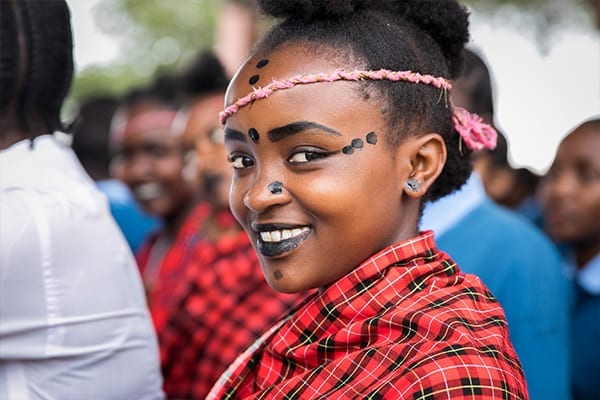
"This is the day where Tanzanians express their feelings," says Faith, who is dressed in an ankle-length dress splashed with a bright palette of colours, and topped with a 'kilemba' (Kiswahili for headwear) carefully wrapped around her head.
As the morning transitions into the afternoon, everyone’s attention turns to the much-anticipated fashion show.
“It feels so good to be a part of it,” says Agnes, a Form 6 student who is modelling for a group called Design a New Africa (DANA). “Everyone always waits for the fashion show.”
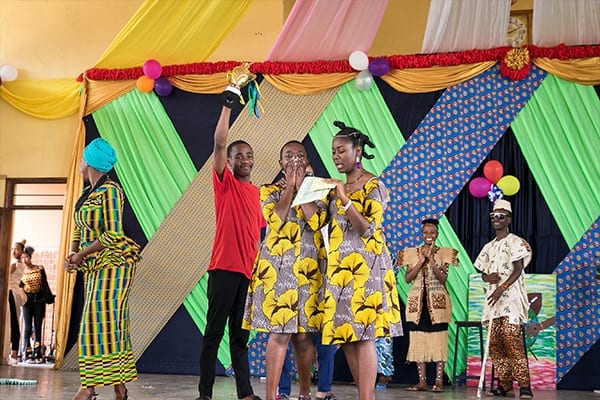
Pandemonium ensues, Elay and Gift hug each other and rush onto the stage to accept their award; the crowd are on their feet and whooping.
“If you want to show your talent,” says Elay. “You need to take the chances the school provides.”
The rain has now eased off, and the celebration continues. Help St Jude’s support students to achieve their dreams of tomorrow by sponsoring a student today.
'Welcome to our project, says Stephen, gesturing with a smile towards a table showcasing his science project: a computer and a model of a house. 'It's known as 'Alice', the home optimisation system.
Stephen is standing next to his co-creator, friend and fellow Form 4 student, John. The pair, who have worked on projects together since primary school, recently won the Perpetual Trophy for innovation, awarded by Young Scientists Tanzania, for the project they developed for this years' St Jude's Science Fair.
'We researched the problems facing Tanzania, says Stephen, 17. 'So we thought of security problems - people breaking into homes.
The annual Science Fair is a unique opportunity for students to innovate, experiment and get hands on experience with developing an invention from scratch.
This year was the ninth Science Fair for St Jude's, where students present science-based projects that can impact the community. The Fair is attended by over 1,000 students, as well as staff, visitors, and students from nearby government schools.
'We are always doing projects to help our society and community, says John, 18, who mainly worked on the hardware for Alice. 'We really want to improve the security systems available in our country.
Alice is composed of three modules: security, home automation, and personal assistance.
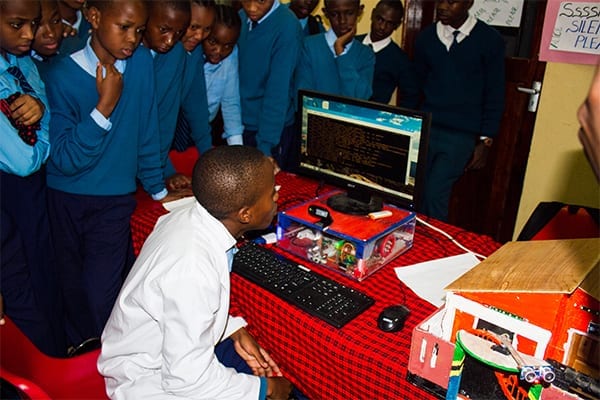
'Let's start with security, says Stephen, sitting down next to the house model, and pointing towards a mini-camera that is located above the house
gate.
The mini-camera begins scanning the area in front of the gate, using light and motion sensors.
'When anybody comes near your house, the camera picks it up and triggers an alarm inside the house, says Stephen, who worked on the programming for the project.
The gate itself has a knocking system, which allows the owner of the house to encode a specific knock sequence.
'If somebody knocks the correct pattern, says Stephen. 'The gate will open automatically.
The next feature of Alice is the home automation system, which consists of a solar panel tracker that sits on the roof, tracking the sun in order to charge the system.
'This can be used not just in houses, says John, 'but also in public buildings - in hotels, hospitals or supermarkets.
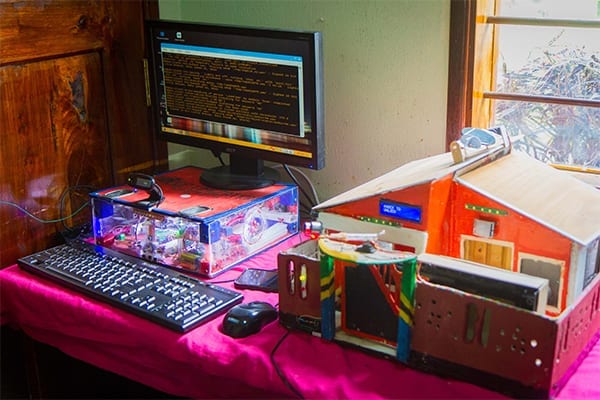
The final part of Alice is the personal assistance component.
'This will help you control everything in the house using voice command, says John, prodding Stephen to show an example.
Leaning towards the computer, Stephens says - 'Alice, play music.
The computer responds instantly.
'Please specify your type of music, replies a cool female, robotic voice.
'Alice, play bongo flava music, says Stephen, selecting a popular genre of Tanzanian hip hop.
After a slight pause, the sound of a raft of instruments with Swahili vocals fills the room.
Stephen and John first came up with the concept of Alice last November and began putting it together with the goal of presenting it at the St Jude's Science Fair in March of this year.
The two teenagers would find time to work on Alice during the week at Mr Dennis' Programming Club and even on weekends.
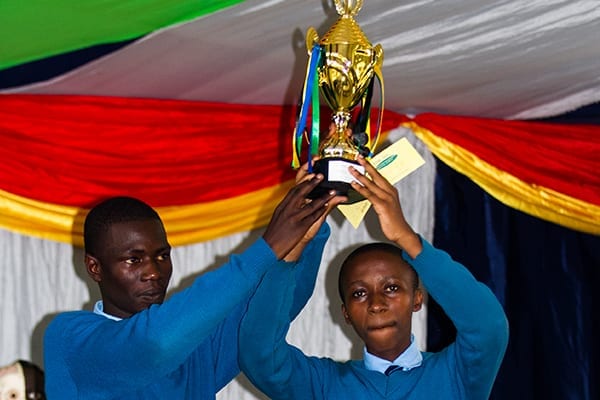
'Being at St Jude's you get exposed to different people and different experiences, says John. 'You get to share ideas. St Jude's provided us with the 'Raspberry Pi board', (a small, single board computer developed in the United Kingdom that converts spoken words to text via a 'speech to text engine' known as TTS), when we were developing our project.
Because of the resources and support provided by St Jude's, the two students, in addition to winning their award, were also able to present Alice to the Tanzanian Commission for Science and Technology (COSTECH) and have plans to develop their prototype further.
Make a donation to support St Jude's bright young scientists to become the
leaders of innovation in Tanzania.
On a sunny Thursday morning, at a government secondary school only ten minutes from St Jude’s, just over 50 students are crammed into a classroom. Cables hang from the tin ceiling, the paint on the walls is peeling and at the back of the classroom runs a long wooden bench, where students who aren’t lucky enough to have a desk are crammed shoulder-to-shoulder.
Zulfa, a 2019 St Jude’s graduate who is teaching commerce and business as part of her Community Service Year, walks into the classroom followed by 15 visitors.
The guests are 12 students, and three teachers from Methodist Ladies’ College (MLC), an all-girls school in Melbourne, Australia.
As the girls roam the classroom, they struggle to communicate as the local students speak little English.
Not the kind to give up, the MLC girls decide to sing a song they’ve learnt whilst being here that is popular amongst Tanzanian youth.
“Esther!” sing the girls, from the front of the classroom. “Hello sister!”
The class catch on, recognising the tune.
“I say come here,” sing the Tanzanian and Australian students together. “Look at the motor car!”
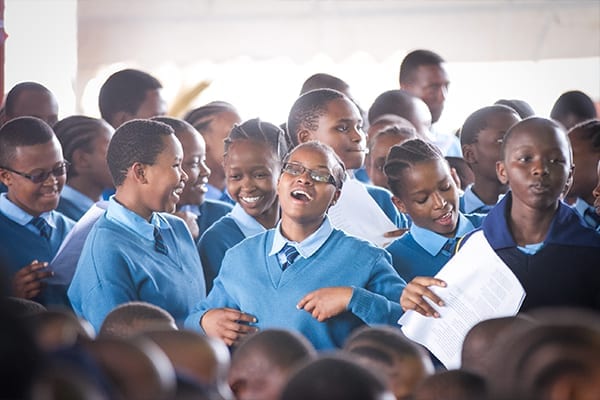
Some of the students begin standing up around the classroom, joining in with the MLC girls, dancing and pretending to drive a car – “shake your body, body, body!”
As the song finishes, Zulfa leads the visitors out of the classroom and into the yard. She begins talking about her experience teaching at a government school, and how this compares to her time at St Jude's.
“There are three main differences between St Jude’s and this school,” Zulfa tells her guests.
The first difference is the students’ lack of English skills, the second lies in outdated learning techniques and the final is a lack of resources.
“When it comes to exams, students will be paired off,” says Zulfa. “One will be given access to a desk and chair, the other will have to go outside, sit on the ground and write using their thigh for support.”
Teachers have to buy their own textbooks, supplying notes to all the students. The library is located in a shed; the shelves are half empty. The school has 1,453 students.
As the girls stand in the hot midday sun, a boy sprints across the yard to a tyre rim, hanging from a tree. He pulls out a stick and begins whacking the rusty relic to begin recess – clang, clang, clang!
Students begin spilling out of their classrooms, rushing towards the Australians.
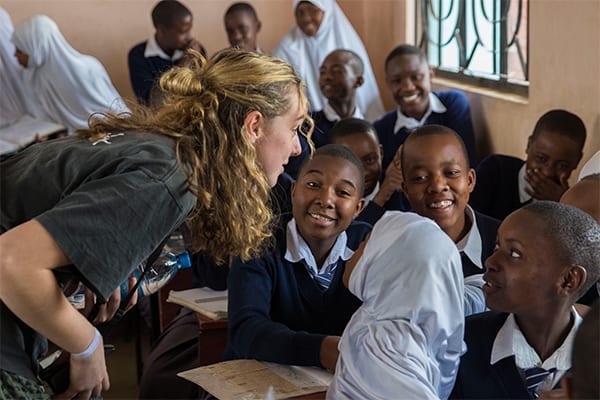
One of the MLC students, Allie, begins talking with a girl about what she wants to do in the future.
“I like it when I hear girls say they want to be a doctor or a lawyer,” says Allie. “It’s comforting, and makes me feel proud.”
In Tanzania, the majority of girls will leave school before their twelfth birthday.
“By giving girls an education,” says Zulfa. “You can get rid of early marriage, young pregnancy, and child labour.”
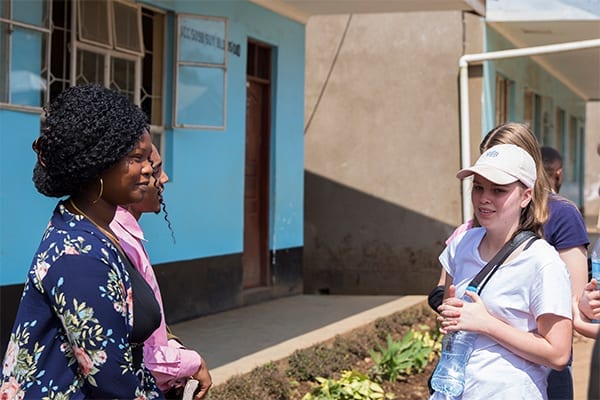
For this reason, Zulfa is excited that St Jude’s will be opening a new all-girls campus in Moshono for hundreds of secondary students.
“It’s important that girls have a space of their own,” says Zulfa. “To push each other, to become the doctors and engineers of the future.”
Emily, another of the MLC group, agrees with Zulfa.
“At MLC, we empower girls,” says Emily. “St Jude’s having an all-girls campus will do the same thing.”
Experience your own immersion into Tanzanian life and culture and see the impact St Jude’s is having on the community, organise a visit today.
“Good afternoon, Mr Kephas!” sing 25 seven-year-old students as one. They are sitting in the shape of a horseshoe, their feet dangling from wooden benches, not quite touching the ground.
Mr Khepas breezes into the classroom, laughing, his arms spread wide. He is wearing a suit, with a light blue shirt and polished shoes. This is an unusual outfit for an art teacher.
“People wearing suits are usually lawyers or accountants,” he says. “But as an artist, you can wear a suit.”
Surrounding him is his Standard 2 class for the afternoon.
“What will we be doing today?” asks Mr Kephas, holding up a piece of paper with an outline of a shirt sketched onto it, as a clue.
The students rush to answer, eager to impress the popular Mr Kephas.
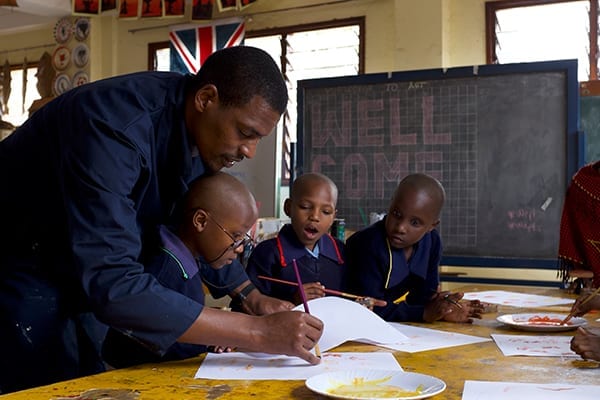
“Printing!”
“Pressing!”
“Stamping!”
“Yes!” says Mr Kephas triumphantly. “What do we say for great responses?”
“You are a superstar! You are a superstar!” the class say in unison to the students who gave the correct answers.
From a young age, Mr Kephas knew he wanted to be a teacher. At the age of fifteen, he began running classes for his cousins and neighbours out of his home in Mianzini, teaching not just art, but also science and mathematics.
He has now been working at St Jude’s for seven years, having first heard about the school from one of his friends.
“I come from a poor background,” Mr Kephas shares. “So when I discovered that St Jude’s provides a free education for poor children, I knew this was a great thing.”
When Mr Kephas was a boy he would sit on the ground, using sticks to draw in the dirt, boxes to make cars, and discarded plastic bottles to build models of houses. Occasionally his mother would find paper for him to draw on.
“I express my feelings and my ideas through art,” he says.
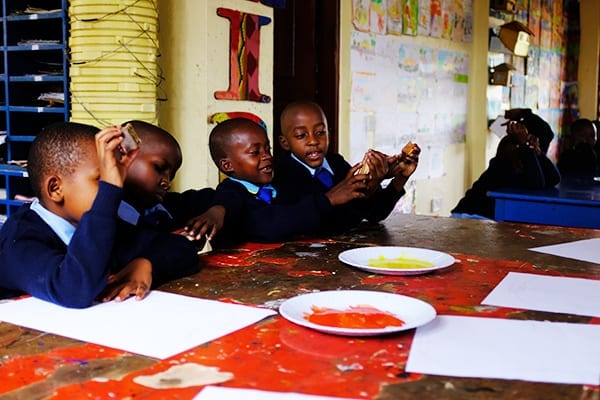
This is an idea Mr Kephas aims to extend to his students, by providing a sense of belonging in the classroom.
“What they do is what I display in the art room,” he says. “It’s not what I do. It will help them feel that this is the place where they belong.”
The art room is an explosion of colour. Lining the walls are depictions of lions, elephants and rhinoceros; hanging from the ceiling are whacky designs of handbags. At the front, on the blackboard, it reads “WELCOME!” written in bright, pink chalk.
Mr Kephas distributes the paint, and hands out the stamps with carved images of echidnas, platypuses, koalas, and boomerangs, adding some Australiana to the typical Tanzanian selection.
In the corner sits a boy named Brayan. He is particularly eager and the first to begin, breathlessly covering his paper with stamps of echidnas.
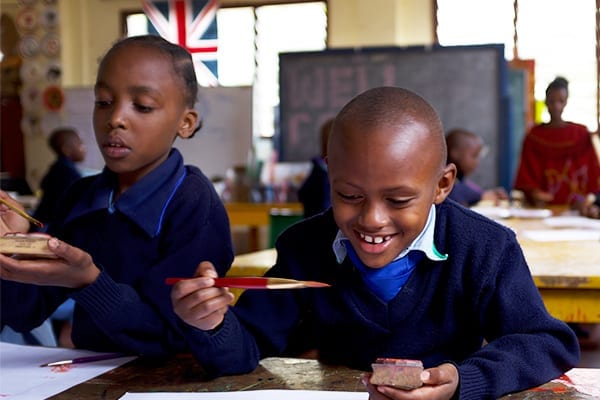
Seated next to Brayan is Magreth who has covered her paper with possums. When Magreth grows up she wants to be a teacher just like Mr Kephas. “He always makes me laugh, and I learn a lot,” she says.
Opposite Brayan and Magreth, is Isaya who is methodically working away. Isaya likes to entertain his peers by standing at the front of the class and telling them stories. Despite his storytelling skills, he aspires to be a doctor one day, “I want to help everyone!” he declares.
“Okay,” says Mr Kephas, raising his voice above the thud, thud, thud of the stamping. “Time to hold up your work!”
The children surround Mr Kephas, proudly showing off their artwork, laughing and vying for his attention.
“Today, I am impressed with all of you,” he says. “You will all get stickers. How many do you want – three?”
“Four!” cry the students. “We want four!”
Mr Kephas throws his head back, and laughs.
Without passionate, committed teachers, our students wouldn’t get the holistic, quality education they need to become the future teachers and doctors they dream of being. Your donations make this possible, donate today.